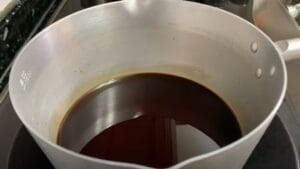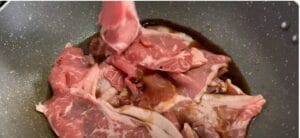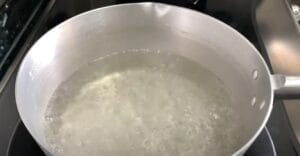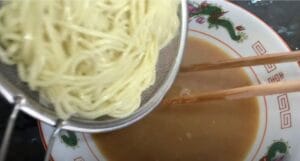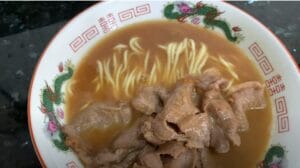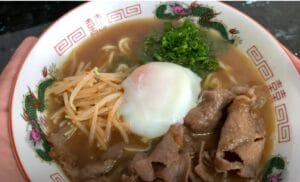Make Sukiyaki Ramen at home! A delightful recipe that combines tender beef & noodles in a rich broth.
As I sit here on a cold winter evening, a craving for something warm and comforting strikes me. My mind immediately goes to the rich, sweet and savory flavors of sukiyaki, that classic Japanese hot pot dish made with thinly sliced beef and vegetables simmered in a sweet soy broth.
I fondly recall my first taste of sukiyaki during a trip to Japan a few years ago. The sizzling pot filled with marbled beef, tofu, mushrooms and greens was placed in the middle of our table. As we cooked the ingredients in the bubbling broth, the savory aromas filled the intimate restaurant. With the first bite, I was transported – the soft, velvety beef contrasting with the crunchy vegetables coated in the glistening brown sauce was utter perfection to me.
Ever since that memorable meal, I’ve been trying to recreate the flavors and experience of sukiyaki at home. While my attempts have been decent, they’ve never fully measured up to my nostalgic memory of that cozy restaurant in Japan.
In pondering what could take my homemade sukiyaki to the next level, a light bulb went off – what if I incorporated those familiar ramen flavors into the dish? The savory shoyu broth base found in many ramen styles would likely pair beautifully with the typical sukiyaki ingredients. And ramen toppings like seasoned eggs, pork belly and scallions would provide delicious textural contrast and added depth of flavor.
I’m excited to develop my own unique take on sukiyaki by fusing it with classic ramen elements. As a recipe developer at Food and Meal, it brings me joy to put creative spins on traditional dishes. And I have a good feeling “sukiyaki ramen” will not only satisfy my comfort food craving, but also wow the tastebuds of anyone lucky enough to enjoy a steaming bowl. I can’t wait to simmer up a batch and see how these two iconic Japanese foods meld together!
I’d love to hear your thoughts on fun fusion dishes in the comments below! What’s your favorite food mashup?
What noodles for sukiyaki ?
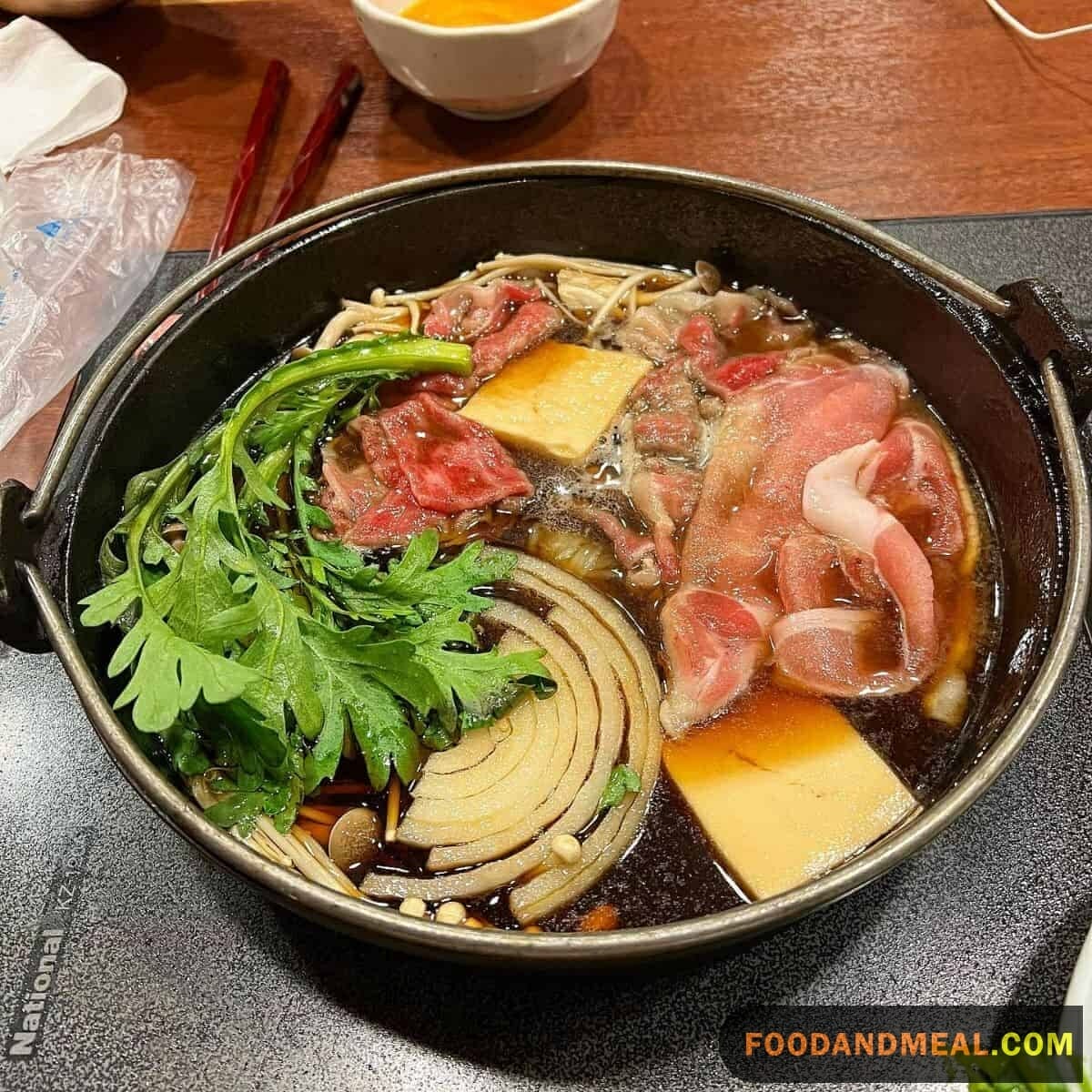
Traditionally, ito konnyaku or shirataki noodles are used in sukiyaki. These noodles are made from konjac yam and have a unique, slightly chewy texture that absorbs the savory-sweet sukiyaki broth beautifully. There’s a certain anticipation that builds when preparing these noodles; their glossy appearance and slippery texture add an intriguing contrast to the other ingredients in the pot.
From a personal standpoint, the inclusion of ito konnyaku or shirataki noodles in sukiyaki is a nod to tradition and authenticity. However, some may choose to use other types of noodles such as udon. Udon noodles, with their thick and soft texture, can offer a more substantial bite, which can be very satisfying, especially on a cold day. The way they soak up the broth and provide a comforting chewiness can evoke feelings of warmth and contentment.
Sukiyaki Ramen Recipes
Sukiyaki Beef Ramen is a Japanese dish that combines tender, steamed beef with a broth full of bold flavors from soy sauce, sugar, and mirin. The soup is usually accompanied by raw eggs. It is a great dish for any meal, and it is perfect with sushi. If you’re in OREM, you can’t go wrong with this tasty dish.
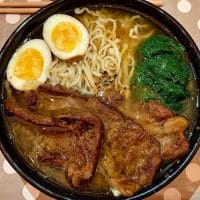
Sukiyaki Beef Ramen
Ingredients
- 4 cups water
- 1 cup mirin sweet rice wine
- 1 cup sake
- ¾ cup soy sauce
- ½ cup sugar
- 2 pounds thinly sliced lean beef such as sirloin
- ½ cup Shoyu Tare
- 5 cups any type clear soup
- 1⅓ pounds fresh noodles ⅓ pound per bowl, such as Chukasuimen
- negi
Instructions
- First, prepare the sukiyaki topping by combining the water, mirin, sake, soy sauce, and sugar in a large saucepan. Heat it over medium heat until the liquid starts to simmer.

- Add the sliced beef and cook for 3 minutes.

- Remove the pan from the heat and leave the cooked sukiyaki beef in the liquid.

- With all your ingredients ready to go, bring a large pot of water to a boil over medium-high heat.

- Heat your ramen bowls by filling them halfway with hot water. The bowls don’t need to be scalding, but they should be hot to the touch. Dump out the hot water and dry the bowls with some paper towels or a clean towel.

- Put the tare and soup in a medium saucepan. Mix and bring to a simmer over low heat.

- Cook the noodles in the large pot of boiling water. Ramen that has been cut to a standard thickness (about 1 mm) will cook in 1 to 2 minutes.

- About 30 seconds before the noodles are finished cooking, ladle the soup into the ramen bowls.

- Drain the noodles, taking care to shake off as much excess water as you can. Carefully place some noodles in each bowl of soup, keeping them tidy.

- Place a sprinkle of negi neatly on the ramen, then spoon on the sukiyaki beef topping. A little of the sukiyaki liquid is okay, too, but the flavor is strong, so use sparingly.

- Serve immediately.

Video
Notes
- Traditional sukiyaki is served as a kind of hot pot. Thinly sliced beef is simmered in a flavored liquid right at the table, along with vegetables, noodles, and tofu.
- Soup: Mix equal parts unseasoned low-sodium chicken broth and dashi broth. Japanese dashi powder to make broth can be found in the Asian foods section of many supermarkets or in Asian grocery stores or online.
- Noodles: Use 3 ounces of dried ramen noodles per bowl, preferably the thin, straight style.
Nutrition
© Food And Meal
This website provides approximate nutrition information for convenience and as a courtesy only. Nutrition data is gathered primarily from the Spoonacular Database, whenever available, or otherwise other online calculators.
How to make Sukiyaki Beef Ramen in a Pressure Cooker
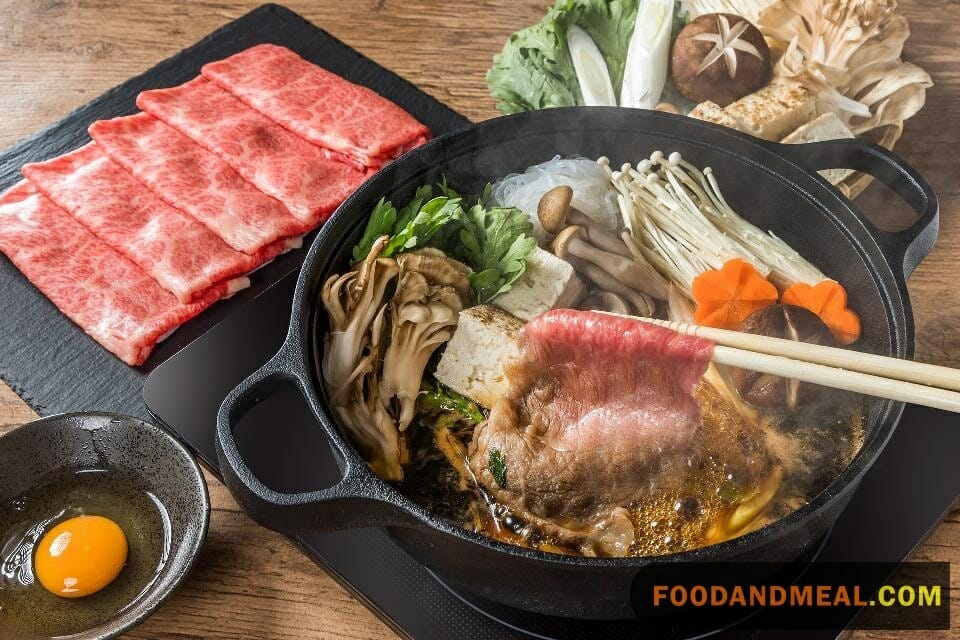
To begin, one must consider the broth, which is the soul of any ramen. In a pressure cooker, the broth can be made quickly yet still develop layers of flavor that would typically take hours. Start by gently sautéing aromatics like garlic and ginger to release their fragrant oils, then add a quality dashi stock as the foundation. The addition of soy sauce, mirin, and a hint of sugar will create that signature sukiyaki sweetness and depth. The pressure cooker allows these flavors to meld together under high pressure, creating a rich and savory broth in a fraction of the traditional time.
For the beef, the pressure cooker again works wonders. Choosing a cut like chuck or brisket, which benefits from the moist cooking environment, will result in tender slices that melt in the mouth. It’s important to sear the beef first, as this step adds a beautiful caramelization that enhances the overall flavor profile. Once seared, the beef can be set aside while you build the broth in the pressure cooker.
Vegetables are an essential component, adding freshness and crunch to the dish. Traditional sukiyaki vegetables such as shiitake mushrooms, Napa cabbage, and green onions can be prepared while the broth is cooking. Cutting them into bite-sized pieces ensures they cook evenly and are easy to eat.
The emotional aspect of using a pressure cooker for Sukiyaki Beef Ramen is one of anticipation and excitement. There’s a sense of wonder in how quickly it can transform raw ingredients into something so rich and satisfying. The pressure cooker also simplifies the process, allowing more time to savor the experience of cooking and the joy of sharing the meal with others.
Tips for making Sukiyaki Beef Ramen
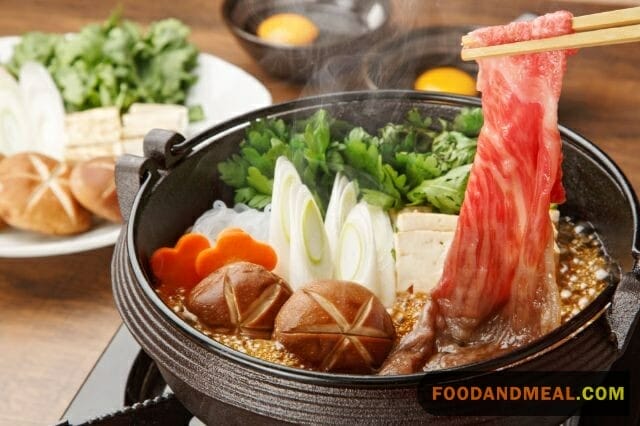
Serving Suggestions
This sukiyaki ramen fusion would pair nicely with some classic Japanese gyoza dumplings or shrimp tempura on the side. The sweet and savory flavors would also complement karaage fried chicken or a refreshing seaweed salad.
For a more filling meal, serve it with oyakodon – a Japanese rice bowl dish with chicken, egg, and onions simmered in a sweet and salty broth. The runny egg yolk in the oyakodon would mix deliciously into the sukiyaki ramen.
Some lighter sides that would allow the rich sukiyaki ramen flavors to shine include sliced cucumbers or radishes with a ponzu citrus soy dipping sauce, refreshing daikon radish salad, or a simple miso soup with tofu and wakame seaweed.
I’d love to see what creative sides you all come up with for this inventive ramen dish! Share your favorite flavor pairings below.
Cooking Tips
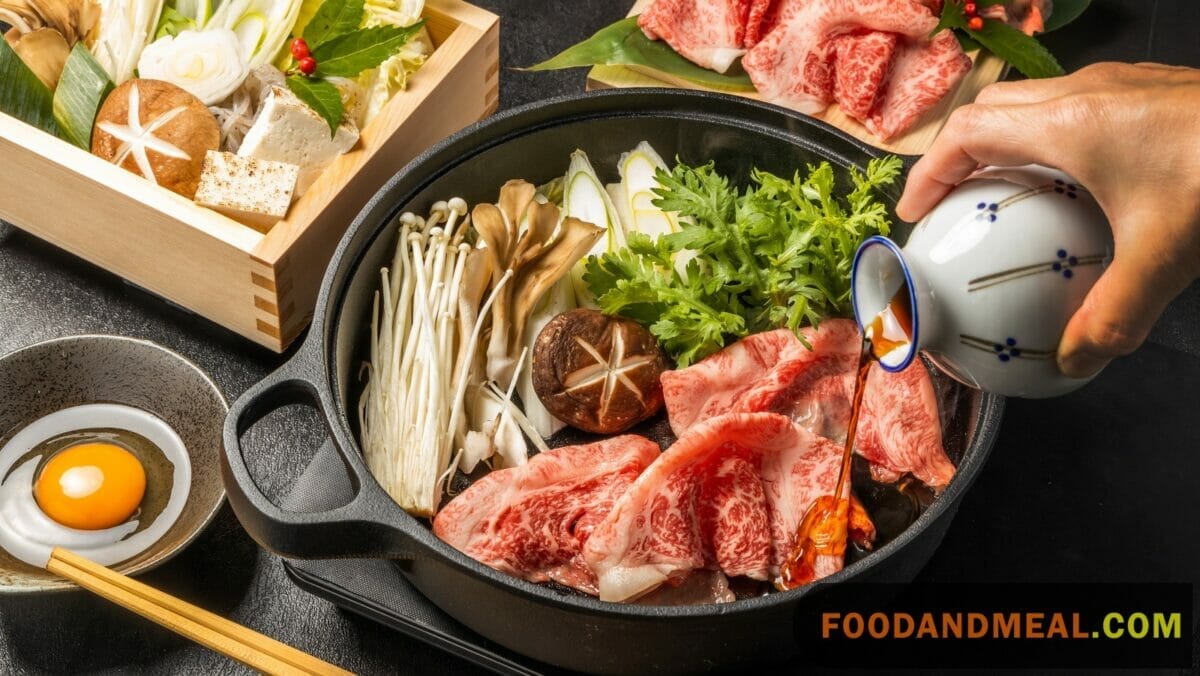
Firstly, the broth is the heart of any ramen, and for Sukiyaki Ramen, it should exude a sense of umami while maintaining a delicate sweetness characteristic of sukiyaki. A tip here would be to start with a good quality dashi as a base, adding soy sauce, mirin, and a touch of sugar. This creates a harmonious blend that is both deep and slightly sweet.
When it comes to the beef, which is central to sukiyaki, selecting a well-marbled cut allows for tenderness and flavor. It should be thinly sliced to ensure that it cooks quickly and absorbs the broth tastefully. The beef can be lightly seared before being added to the ramen or simmered directly in the broth for a short time to maintain its succulence.
Vegetables add both nutrition and texture to the dish. Traditional sukiyaki vegetables like shiitake mushrooms, Napa cabbage, and green onions are excellent. They should be cut consistently to ensure even cooking and aesthetically pleasing presentation. Additionally, items like tofu and shirataki noodles, which are commonly found in sukiyaki, can also be incorporated to add variety.
In my opinion, the magic of Sukiyaki Ramen lies in its versatility. It allows for personalization—whether that’s in the choice of vegetables, the addition of spices for those who prefer a kick, or even the type of noodles used. Each bowl can be a reflection of individual taste while still honoring the traditional flavors.
Top 9 FAQs about Sukiyaki Beef Ramen
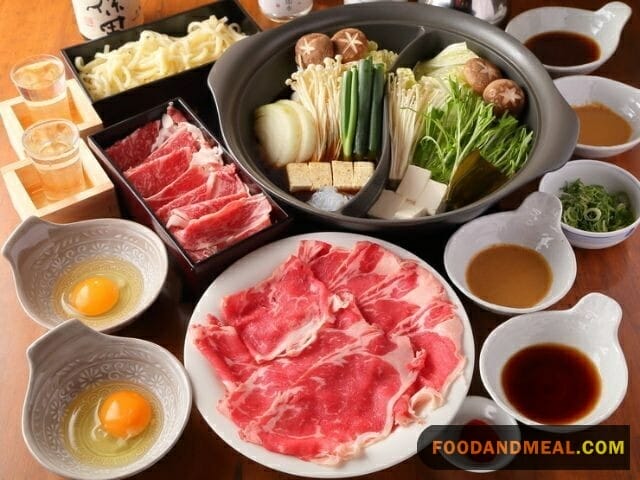
- What is sukiyaki soup made of? Sukiyaki soup is typically made with a mixture of soy sauce, sugar, mirin (sweet rice wine), and sake. This creates a savory-sweet broth that complements the ingredients cooked in it.
- What is the flavor of sukiyaki? Sukiyaki has a rich and savory flavor with a perfect balance of sweetness and umami. The broth, combined with the natural juices from the ingredients, contributes to its distinctive taste.
- What does sukiyaki mean in Japanese? In Japanese, “sukiyaki” (すき焼き) is a term that combines “suki” (すき), meaning “to slice thinly,” and “yaki” (焼き), meaning “to grill” or “to cook.” It refers to a hot pot dish where thinly sliced meat and various vegetables are cooked in a soy-based broth at the table.
- What are sukiyaki noodles made of? Sukiyaki is traditionally served with rice, not noodles. However, if you want to incorporate noodles, they are typically made from wheat flour, water, salt, and sometimes egg. Ramen noodles or udon noodles are common choices.
- Can I use other meats besides beef? Absolutely! While traditional sukiyaki uses beef, you can experiment with thinly sliced pork, chicken, or even seafood for a unique twist.
- Is it necessary to use a pressure cooker? While a pressure cooker speeds up the cooking process, you can also make this dish on the stovetop. Simply adjust the cooking times accordingly.
- How do I store leftover Sukiyaki Beef Ramen? Store any leftovers in an airtight container in the refrigerator for up to 2-3 days. Reheat gently on the stove or in the microwave.
- Can I make this dish vegetarian or vegan? Yes, you can create a vegetarian version by using tofu or seitan and vegetable broth. For a vegan version, ensure that your mirin and sake are vegan-friendly.
- Can I prepare the sukiyaki sauce in advance? Certainly! You can make the sukiyaki sauce ahead of time and store it in the refrigerator until you’re ready to cook.
Conclution
In closing, fusing the rich, sweet and savory flavors of sukiyaki with the complex, umami-packed broth and toppings of ramen just feels so right to me. This inventive dish not only satisfies my craving for comfort food, but also allows me to flex my creative muscles as a recipe developer. I can’t wait for you all to try “sukiyaki ramen noodle soup” and let me know what you think!
Does mixing two iconic dishes inspire you to get into the kitchen? What flavor combos are you dying to try? Let your imagination run wild and share your ideas below! Thanks for joining me on this tasty thought experiment. Now if you’ll excuse me, I have a steaming pot calling my name.
I'm James F Anderson, a noted sous chef from London and a Le Cordon Bleu alumnus. My career began in a Michelin-starred Parisian eatery, where my blend of classic and contemporary cooking, using seasonal ingredients, earned accolades. Recognized in culinary publications and on cooking shows, I’m committed to mentoring aspiring chefs and delivering memorable dining experiences, marking me as a standout talent in the culinary world.





